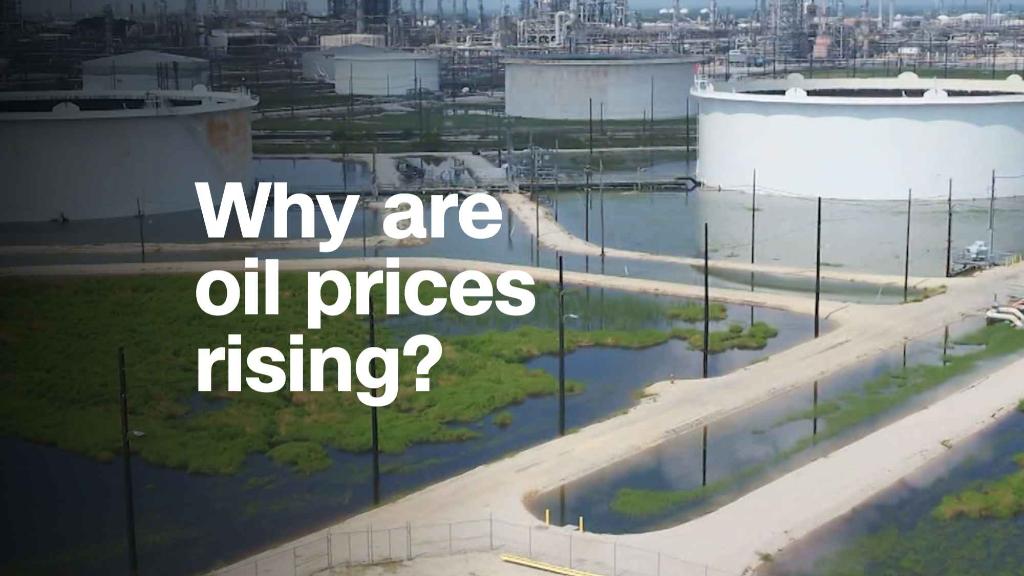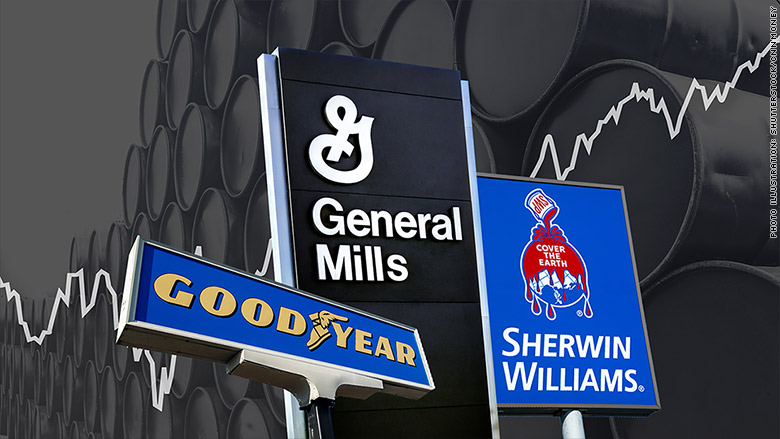
A 50% spike in the price of crude oil over the past year has set off a celebration for Big Oil. But it's sending shudders through other major businesses.
Fears that President Trump will kill the Iran nuclear agreement lifted crude above $70 a barrel late Sunday for the first time since late 2014. Wall Street is already banking on fatter profits for the likes of ExxonMobil (XOM), Chevron (CVX) and shale giant Continental Resources (CLR).
Yet the return of higher oil prices — and $3-a-gallon gas — will also be greeted with eye rolls, not just by American drivers but by CEOs of big companies like Hershey (HSY) and Sherwin-Williams (SHW). More expensive oil will eat into their bottom line.
That's especially true for certain chemicals, paper packaging, retail, transportation and packaged food companies.
Chemicals makers are particularly vulnerable because they use crude oil as a major ingredient. Polyone (POL), Univar (UNVR) and KMG Chemicals have at least half of their production costs in oil and products derived from petroleum, according to Goldman Sachs.
Eastman Chemical (EMN), Huntsman (HUN) and paint giant Sherwin-Williams spend nearly as much on oil.
Raw materials costs are "all heading in the wrong direction," Sherwin-Williams chief financial officer Allen Mistysyn recently told analysts.
Oil is also a major expense for Goodyear Tire & Rubber (GT), as well as auto parts companies such as AutoZone (AZO), Advance Auto Parts (AAP) and Adient (ADNT).
Related: Oil markets brace for Trump to kill Iran deal

Consumer products companies are likewise nervously watching the rising price of raw materials, especially crude oil.
For instance, Goldman Sachs found that oil and oil products make up at least 18% of expenses for Hershey, Estee Lauder (EL), Clorox (CLX), Mondelez (MDLZ) and Church & Dwight. These companies spend on oil to manufacture, package and ship their products to customers.
Other big oil spenders in consumer goods include Post-It maker 3M (MMM), Haagen-Dazs and Cheerios maker General Mills (GIS), and JM Smucker (SJM).
CEOs have recently warned that they are already grappling with the higher cost of raw materials, especially steel and aluminum, which have become more expensive since President Trump imposed tariffs.
"Obviously with the oil price at $70, that just puts further pressure," Whirlpool (WHR) CEO Marc Bitzer said during a recent call with analysts.
Higher oil prices can be a double whammy for consumer companies. Not only are their expenses higher, but Americans will have less disposable money to spend at the stores if they're dealing with pain at the gas pump.
Airlines are also bracing for higher fuel costs. American Airlines (AAL) CEO Douglas Parker noted on April 26 that oil prices have spiked 60% from last summer. "That's a big increase over a short period of time," Parker warned, adding that it will have a "material" impact on all airlines.
Related: Rising costs start to squeeze American businesses
The good news is that many major companies, especially airlines, use hedging strategies to lock in energy prices when they're low. That means the pain from higher prices may not be immediate.
Other companies should be able to pass along higher energy costs to their customers, especially because the US and world economies are healthy. The US unemployment rate fell below 4% in April for the first time since 2000.
The surge in oil prices has been driven by a range of factors, including robust demand and production cuts by Russia and OPEC countries.
More recently, the oil market has been lifted by geopolitical factors such as plunging output in Venezuela and, now, expectations that Trump will re-impose sanctions on Iran. Trump faces a May 12 deadline to decide the fate of the Iran nuclear deal.
Tamas Varga, lead analyst at brokerage firm PVM Oil Associates, predicted "panic buying" that will briefly lift benchmark US oil prices to $75 a barrel if Trump snaps sanctions back on Iran.
Related: $3 gas coming to a station near you
The big question will be whether Iran's major customers — China, India, South Korea and the European Union — comply with new sanctions. There has been considerable pushback, especially in Europe, to Trump's bid to rip up the Iran nuclear deal.
On the other hand, crude oil prices could plunge if Trump surprises the market and re-certifies the Iran deal.
In the longer term, the surge in oil prices could be contained by two major factors.
First, oil traders will be watching closely to see how fast shale drillers in the United States respond to $70 oil by ramping up more production. A healthy dose of new US output could cool the market off.
And at a certain point, high prices are likely to cure themselves. Varga said "demand destruction" will eventually "limit any upside."


